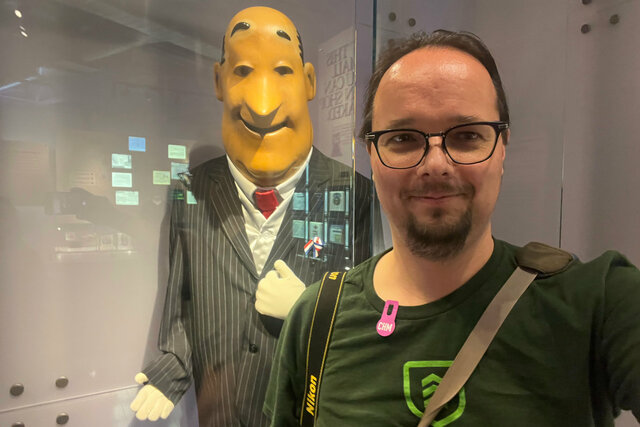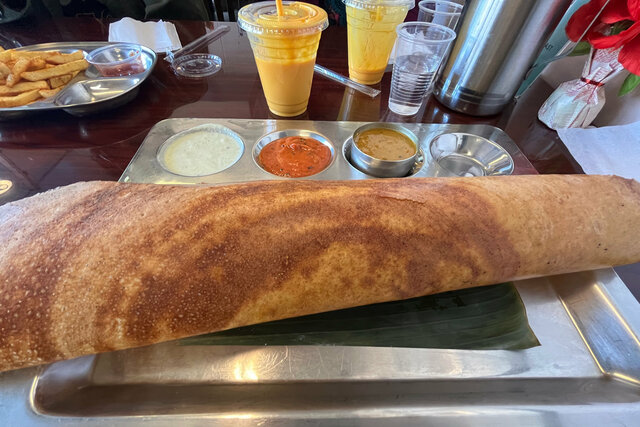Computer History
Started: 2024-05-28 21:11:19
Submitted: 2024-05-28 23:10:27
Visibility: World-readable
A family outing to see the Computer History Museum in Mountain View
In February, on our way to Chinese New Year, we talked about what sort of museums and outings everyone would be interested in, to help me best target family outings. (I was driving, so Kiesa took notes.) I asked about computer history museums and Calvin said "possibly" and Julian said "probably", which sounded like the best endorsement I was going to get.
There is one museum in Mountain View specifically dedicated to computer history, so it seemed like a reasonable target for a family outing. We visited the Computer History Museum in Mountain View on a Saturday afternoon at the end of April.
We visited the museum on a bright sunny afternoon. The first thing we tried to see was the IBM 1401 computer room, which was packed with people for a guided demo, and too crowded to really follow what was happening from the back of the room. (I saw the IBM 1401 in action, and got my own punched card and fan-fold printout, on my last visit to the museum in 2018.) The first thing we really saw was in the lobby, before entering the main sequence of exhibits: a Waymo concept car, from the era when Waymo was building its own tiny cars to poke around Mountain View. This tiny car had two seats and no way to control the car at all, only a screen to enter the destination and a stop button.
The main exhibits took us back in time to mechanical computation devices, including abacuses, logarithms, Napier's bones, slide rules, and a reproduction of part of Babbage's difference engine. Next was early electric tabulating machines, mostly based on punched cards, including a card sorter that operated as a radix sort when sorting multi-character records. I tried to explain what punched cards were and how they worked (and how the 80-column limit, based in part on human factors, still influences the default terminal size I'm using to type this blog post), but I'm not sure my kids grasped what I was trying to say.
We saw early analog computers, and I tried to point out how one would "program" the computer by plugging in wires between the various analog stages. We saw networked computer systems designed to track attacking Soviet bombers. There was a room full of minicomputers, including a weird "kitchen computer" with sleek curves made of bright orange plastic that looked like it'd fit in a mid-century modern house but without an obvious display or any way for it to actually be useful. These computers were mostly labeled to identify the system's capabilities in terms of operations per second, memory storage, and permanent storage; although miniscule by modern standards, it at least gave me a framework for understanding what the computer was capable of.
A side gallery talked about integrated circuits and included a display of generations of x86 processors produced by Intel. This display included the process nodes on the labels, showing the march of miniaturization: 3 μm for the 8086 down to 90 nm for the Pentium 4, produced in 2000. (Like most of the exhibits in the museum, this display hadn't been updated since the current museum was opened 24 years ago; it could only begin to imagine the 3 nm process node that TSMC is now shipping and Intel is expecting to ship this year.)
The next display had a much smaller set of processors more interesting to my current line of work: several RISC processors from the 1990s, the spiritual predecessors to the RISC-V work my current employer is doing.
There were a couple of diversions into robotics and graphics and music before the kids found the exhibit they were interested in: computer games, starting with Pong, and moving on to more advanced computer games. Many were presented in their original boxes and media, with the mass-market game consoles that they were played on; some were playable demos that the kids tried (and, more often than not, couldn't quite get the hang of).
Across from the video games was a large display of early personal computers, including my first computer, a Compaq Portable from 1982. (There were other computers I recognized from school and libraries and friends' houses: Apple IIs, TRS-80, Commodore 64; but this was the machine that I spent hours using at home, typing programs in BASIC and learning some of the fundamentals of computing, setting me on a path that led in a straight line to my career today. Julian is now learning Scratch, a graphical programming language in a totally-different environment, and part of me worries that he's not going to have the same fundamental experience I had, but I also hope that whatever experience he has is going to work out because we've come a long ways in the last 35 years.)
The end of the museum crammed in early mobile computing, the birth of the web and the emergence of the Internet into mass culture in the 1990s, then stopped around 2000, just as I was transitioning from an interested amateur through a student into a software professional. I guess I should consider at what point events transition from news into the recent past and onward into history; but if the V&A can acquire and display Google Glass, and the Smithsonian can display Vint Cerf's Nexus One and Tim Geithner's Blackberry, a museum whose very name is "computer history" can continue to acquire and find a way to display and make accessible more recent computer history. (I'm also worried that the best materials are locked up in corporate vaults, kept from public view for fear of exposing trade secrets past the point where those secrets become irrelevant. I'd love to see part of a Google data center from this century (newer than the old rack in the corner), or any of the prototypes and development boards I used at various companies.) But the museum describes the exhibit as "the first 2000 years of computing", and maybe they're sticking with that as a curatorial decision.
The last of the early-Internet-age artifacts was a life-sized Ask Jeeves mascot, set up so I could get a selfie with this relic.
We dropped by the museum store on our way out (I bought a mug with "COFFEE" in binary, and several stickers) then left the museum shortly before closing. Our last stop in Mountain View was supper at Annachikadai, an Indian restaurant which one review reported having "the best dosa in the Bay Area". I have not done an exhaustive survey to determine the veracity of this superlative claim, but I can confirm that the dosa I had was delicious: crispy and huge, with good potato masala and chutneys.
I for one enjoyed the visit to the Computer History Museum, and I think the rest of my family got something out of it as well.









